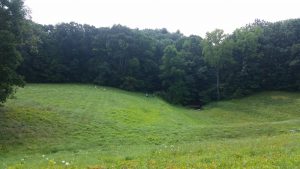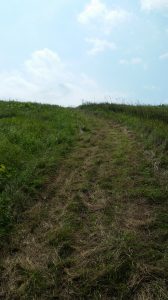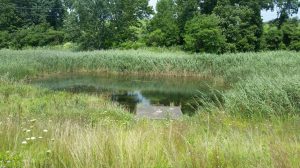WESTFIELD—Dam inspections in the city on Tuesday revealed several items that need addressing, with one location in particular needing attention.
The Massachusetts Department of Conservation and Recreation Office of Dam Safety (DCR-ODS) and the United States Natural Resources Conservation Service (NRCS) came to Westfield to inspect the Arm Brook and Powdermill Brook flood control reservoirs and dams yesterday. The inspections, which were attended by those from several city organizations including a representative of city council, the Westfield Flood Control Commission, Conservation Commission and others, revealed that both dams had work that should be done but Powdermill was in much dire need.

From the top of the dam those inspecting the area of the Arm Brook dam and reservoir can be seen in the distance, wading through brush and vegetation
“The dam really needs a lot of help, a lot of work,” Laurence Boutiette, one of the civil engineers inspecting the dams for NRCS, said of Powdermill.
“Every year we see the same thing,” he added about the dam.
According to Boutiette, the issues with Powdermill include a wearing down of the top of the dam, silt build-up in the reservoir and the primary drainage riser intake tower—which aids in excess waters being drained from the area—has several structural issues.
Boutiette said that the top of the dam has been worn presumably due to human activities, particularly with motorized vehicles like all-terrain vehicles (ATVs) and mopeds. The vehicles have essentially eroded away the top of the dam, which is “designed to function at critical elevations,” Boutiette said.
“It should be level at the top, but it’s down over 4 feet across,” he said.
In the reservoir, Boutiette pointed out that silt has accumulated, which has reduced the amount of space that can be utilized to store flood waters if they came. According to Bouliette, in order to drain the reservoir effectively now, water would have to be pumped.
He recommended that the silt be removed from the reservoir.
Also in the reservoir, the primary drainage intake tower has several pieces of metalwork that Boutiette said should be replaced, which he said is about 50 years old.
However, in spite of the deficiencies, James Lyons, also a civil engineer for NCRS on hand for the inspection, said that the Powdermill Brook dam and reservoir would work to protect residents and property during what he called a “100-year storm event,” or a type of event that would happen once in 100 years.
“Right now it would still provide the intended flood protection for those downstream,” he said.
Another deficiency that Powdermill Brook dam and reservoir had was one that Arm Brook dam and reservoir also shared, which was the overgrowth of vegetation and the need for more grass.
According to Lyons, the grass provides benefit due to better drainage.
“Grasses grow closer together,” he said. “It reduces the potential for erosion.”
By cutting back vegetation however, the city can look to reduce the potential harm of erosion on the dams and allowing grass to flourish more. In spite of this though, the Arm Brook dam and reservoir still appeared satisfactory, including its structure, according to Lyons.
“Can’t say no risk but the dam is satisfactory, providing protection for residents downstream,” he said.



